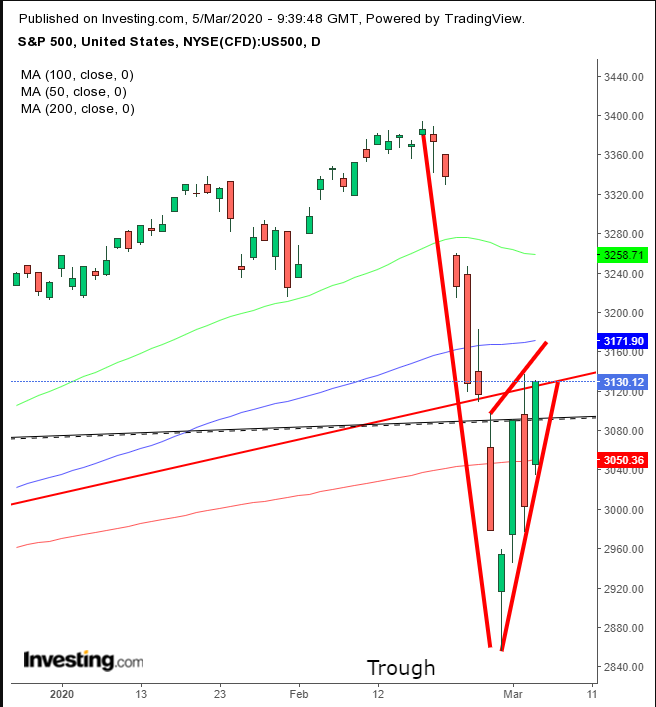
- All Instrument Types
- Indices
- Equities
- ETFs
- Funds
- Commodities
- Currencies
- Crypto
- Bonds
- Certificates
Please try another search

Chart Of The Day: S&P 500 Setting Up For Another Selloff

After yesterday’s second 4% surge for U.S. equity markets within three days, it's clear that bulls are getting hungrier. However, we would urge caution: this exuberance is not likely to last. In fact, we expect the S&P 500 is about to tumble.
Since Friday, which capped the worst sell off in U.S. stocks since the 2008 crash, the benchmark index has zigzagged every day. On Monday the SPX rebounded, surging over 4% after news that Group of Seven finance ministers and central bankers would hold a teleconference Tuesday to discuss how to respond to the fast-spreading coronavirus outbreak.
On Tuesday the index sold off by almost 3% on worries the Fed emergency cut won’t be enough to combat the economic impact of the virus. Finally, yesterday, the average jumped 4% again, after Democratic Presidential hopeful Joe Biden’s Super Tuesday victory allayed investors' concerns of disruptive socialistic changes followed by Congress’ $8 billion cash injection.
Earlier today, U.S. futures bucked the Asian session rally. Bullish investors might have laughed it off as just profit-taking after yesterday’s 4% surge, the second within 3 days. Maybe. But European stocks are lower as well.
So maybe it's not about profit taking. From a technical perspective, the S&P 500’s risk is to the downside.
The S&P 500 index has been converging with an upward tilt since the Feb. 28 bottom, following a straight line down since Feb. 19. That constitutes a rising flag, expected to follow with a downside breakout, after bears drown out all demand at current levels.
The fact that the pattern is developing right after breaking the uptrend line since January 2019, reinforced by the 200 DMA, further indicates the 3,100 level is a red line between bears and bulls. We expect a downside breakout. If one does take place, we’d set our eyes on a repeated down-move equal in intensity to the one that preceded this façade of an equilibrium.
Trading Strategies
Conservative traders would wait for a second trough to form, establishing a downtrend, then wait for a pullback to retest resistance and confirm the downtrend.
Moderate traders are likely to jump in after a downside breakout, preferably on a closing basis.
Aggressive traders may risk a short now, since the price is at the top of the pattern, providing they understand the risk and write an appropriate plan that fits their budget.
Trade Sample - Short Setup
- Entry: 3,130
- Stop-Loss: 3,140, above yesterday’s high
- Risk: 10 points
- Target: 3,000
- Reward: 130 points
- Risk:Reward Ratio: 1:13
Related Articles

• Trump’s trade war, inflation data, and last batch of earnings will be in focus this week. • DoorDash’s imminent inclusion in the S&P 500 is likely to trigger a wave of...

Following the latest IM-2 mission news, Intuitive Machines Inc (NASDAQ:LUNR) stock is down 54% over the month. Presently holding at $8.95 per share, LUNR stock leveled down to an...

Using the Elliott Wave Principle (EWP), we have been tracking the most likely path forward for the Nasdaq 100 (NDX). Although there are many ways to navigate the markets and to...
Are you sure you want to block %USER_NAME%?
By doing so, you and %USER_NAME% will not be able to see any of each other's Investing.com's posts.
%USER_NAME% was successfully added to your Block List
Since you’ve just unblocked this person, you must wait 48 hours before renewing the block.
I feel that this comment is:
Thank You!
Your report has been sent to our moderators for review




Add a Comment
We encourage you to use comments to engage with users, share your perspective and ask questions of authors and each other. However, in order to maintain the high level of discourse we’ve all come to value and expect, please keep the following criteria in mind:
Perpetrators of spam or abuse will be deleted from the site and prohibited from future registration at Investing.com’s discretion.